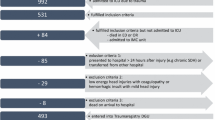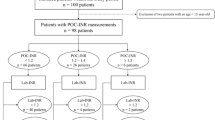Abstract
Objectives
Trauma-induced coagulopathy (TIC) in multiple trauma patients is a potentially lethal complication. Whether quickly available laboratory parameters using point-of-care (POC) blood gas analysis (BGA) may serve as surrogate parameters for standard coagulation parameters is unknown. The present study evaluated TraumaRegister DGU® of the German Trauma Society for correlations between POC BGA parameters and standard coagulation parameters.
Methods
In the setting of 197 trauma centres (172 in Germany), 86,442 patients were analysed between 2005 and 2012. Of these, 40,129 (72 % men) with a mean age 46 ± 21 years underwent further analysis presenting with direct admission from the scene of the accident to a trauma centre, injury severity score (ISS) ≥ 9, complete data available for the calculation of revised injury severity classification prognosis, and blood samples with valid haemoglobin (Hb) measurements taken immediately after emergency department (ED) admission. Correlations between standard coagulation parameters and POC BGA parameters (Hb, base excess [BE], lactate) were tested using Pearson’s test with a two-tailed significance level of p < 0.05. A subgroup analysis including patients with ISS > 16, ISS > 25, ISS > 16 and shock at ED admission, and patients with massive transfusion was likewise carried out.
Results
Correlations were found between Hb and prothrombin time (r = 0.497; p < 0.01), Hb and activated partial thromboplastin time (aPTT; r = −0.414; p < 0.01), and Hb and platelet count (PLT; r = 0.301; p < 0.01). Patients presenting with ISS ≥ 16 and shock (systolic blood pressure < 90 mmHg) at ED admission (n = 4,329) revealed the strongest correlations between Hb and prothrombin time (r = 0.570; p < 0.01), Hb and aPTT (r = −0.457; p < 0.01), and Hb and PLT (r = 0.412; p < 0.01). Significant correlations were also found between BE and prothrombin time (r = −0.365; p < 0.01), and BE and aPTT (r = 0.327, p < 0.01). No correlations were found between Hb, BE and lactate lactate.
Conclusions
POC BGA parameters Hb and BE of multiple trauma patients correlated with standard coagulation parameters in a large database analysis. These correlations were particularly strong in multiple trauma patients presenting with ISS > 16 and shock at ED admission. This may be relevant for hospitals with delayed availability of coagulation studies and those without viscoelastic POC devices. Future studies may determine whether clinical presentation/BGA-oriented coagulation therapy is an appropriate tool for improving outcomes after major trauma.
Zusammenfassung
Ziele
Die traumainduzierte Koagulopathie (trauma-induced coagulopathy, TIC) bei Polytraumapatienten ist eine potentiell letale Komplikation. Es ist nicht bekannt, ob kurzfristig verfügbare Laborparameter einer Point-of-Care-Blutgasanalyse (POC-BGA) als Surrogatparameter von Standardgerinnungsparametern dienen können. In der vorliegenden Studie wurde das TraumaRegister DGU® der deutschen Gesellschaft für Unfallchirurgie nach Korrelationen von Parametern der POC-BGA und Standardgerinnungsparametern ausgewertet.
Methoden
Im Setting von 197 Unfallkliniken (172 in Deutschland) wurden zwischen 2005 und 2012 86.442 Patienten analysiert. 40.129 (72 % männlich) Patienten mit einem Durchschnittsalter von 46 ± 21 Jahren erfüllten folgende Einschlusskriterien: Direkte Aufnahme von der Unfallstelle in eine Unfallklinik, Injury Severity Score (ISS) ≥ 9, vollständigen Datenverfügbarkeit für die Berechnung des revidierten Prognosescores für die Klassifizierung der Verletzungsschwere (RISC) und Blutproben mit validen Messungen von Hämoglobin (Hb), die direkt nach der Aufnahme in die Notaufnahme (emergency department, ED) abgenommen wurden. Korrelationen zwischen Standardgerinnungsparametern und POC-BGA-Parametern (Hb, Base Excess (BE); Laktat) wurden mit dem Pearsontest mit zweiseitigem Signifikanzniveau von p < 0,05 geprüft. Darüber hinaus wurde eine Subgruppenanalyse für Patienten mit ISS > 16, ISS > 25, ISS > 16 und Schock (systolischer Blutdruck < 90 mmHg) bei Aufnahme und für Patienten mit Massivtransfusion durchgeführt.
Ergebnisse
Korrelationen wurden zwischen Hb und Prothrombinzeit (r = 0,497; p < 0,01), Hb und aktivierter partieller Thromboplastinzeit (aPTT) (r = −0,414; p < 0,01) und zwischen Hb und Thrombozytenzahl (PLT) (r = 0,301; p < 0,01) gefunden. Patienten in den untersuchten Subgruppen zeigten dabei zunehmende Korrelation, wobei Patienten mit ISS ≥ 16 und Schock bei Aufnahme (n = 4.329) die stärksten Korrelationen zwischen Hb und Prothrombinzeit (r = 0,570; p < 0,01), Hb und aPTT (r = −0,457; p < 0,01) und zwischen Hb und PLT (r = 0,412; p < 0,01) zeigten. Eine signifikante Korrelation wurde auch zwischen BE und Prothrombinzeit (r = −0,365; p < 0,01) und zwischen BE und aPTT (r = 0,327, p < 0,01) gefunden. Zwischen Hb, BE und Laktat wurden keine Korrelationen gefunden.
Schlussfolgerungen
Die POC-BGA Parameter Hb und BE von Polytraumapatienten korrelierten mit den Standardgerinnungsparametern in der Analyse eines großen Patientenregisters. Diese Korrelationen waren vor allem bei Polytraumapatienten mit einem ISS > 16 und Schock bei Aufnahme ausgeprägt. Das könnte für Krankenhäuser mit verzögerter Verfügbarkeit von Gerinnungstests ebenso relevant sein wie für solche ohne viskoelastische POC-Verfahren. Künftige Studien müssen zeigen, ob eine nach klinischem Erscheinungsbild und/nach Blutgasanalyse orientierte Gerinnungstherapie ein geeignetes Mittel zur Verbesserung der Behandlungsergebnisse nach schwerem Trauma ist.

Similar content being viewed by others

Literature
Brockamp T, Nienaber U, Mutschler M et al (2012) Predicting on-going hemorrhage and transfusion requirement after severe trauma: a validation of six scoring systems and algorithms on the TraumaRegister DGU(R). Crit Care 16:R129
Brohi K, Cohen MJ, Ganter MT et al (2007) Acute traumatic coagulopathy: initiated by hypoperfusion: modulated through the protein C pathway? Ann Surg 245:812–818
Bruns B, Lindsey M, Rowe K et al (2007) Hemoglobin drops within minutes of injuries and predicts need for an intervention to stop hemorrhage. J Trauma 63:312–315
Burns ER, Goldberg SN, Wenz B (1993) Paradoxic effect of multiple mild coagulation factor deficiencies on the Prothrombin time and activated partial Thromboplastin time. Am J Clin Patho 100:94–98
Callcut RA, Cotton BA, Muskat P et al (2013) Defining when to initiate massive transfusion: a validation study of individual massive transfusion triggers in PROMMTT patients. J Trauma Acute Care Surg 74:59–58
Davenport R, Manson J, Death H et al (2011) Functional definition and characterization of acute traumatic coagulopathy. Crit Care Med 39:2652–2658
Davis JW, Parks SN, Kaups KL et al (1996) Admission base deficit predicts transfusion requirements and risk of complications. J Trauma 41:769–774
Fenger-Eriksen C, Lindberg-Larsen M, Christensen AQ et al (2008) Fibrinogen concentrate substitution therapy in patients with massive haemorrhage and low plasma fibrinogen concentrations. Br J Anaesth 101:769–773
Geeraedts LM Jr., Kaasjager HA, Van Vugt AB et al (2009) Exsanguination in trauma: a review of diagnostics and treatment options. Injury 40:11–20
Gonzalez E, Moore EE, Moore HB et al (2014) Trauma-induced Coagulopathy: an institution’s 35 year perspective on practice and research. Scand J Surg 103(2):89–103
Hayakawa M, Gando S, Ono Y et al (2015) Fibrinogen level deteriorates before other routine coagulation parameters and massive transfusion in the early phase of severe trauma: a retrospective observational study. Semin Thromb Hemost 41:35–42
Hilbert P, Hofmann GO, Lefering R et al (2015) Trauma bay haemoglobin level. predictor of coagulation disorder in major trauma. Unfallchirurg 118:601–606
Jackson CM, Esnouf MP (2005) Has the time arrived to replace the quick prothrombin time test for monitoring oral anticoagulant therapy? Clin Chem 51:483–485
Knottenbelt JD (1991) Low initial hemoglobin levels in trauma patients: an important indicator of ongoing hemorrhage. J Trauma 31:1396–1399
Kozek-Langenecker SA, Afshari A, Albaladejo P et al (2013) Management of severe perioperative bleeding: guidelines from the European Society of Anaesthesiology. Eur J Anaesthesiol 30:270–382
Lier H, Bottiger BW, Hinkelbein J et al (2011) Coagulation management in multiple trauma: a systematic review. Intensive Care Med 37:572–582
Macleod JB, Winkler AM, Mccoy CC et al (2014) Early trauma induced coagulopathy (ETIC): prevalence across the injury spectrum. Injury 45:910–915
Maegele M, Brockamp T, Nienaber U et al (2012) Predictive models and algorithms for the need of transfusion including massive transfusion in severely injured patients. Transfus Med Hemother 39:85–97
Murray D, Pennell B, Olson J (1999) Variability of prothrombin time and activated partial thromboplastin time in the diagnosis of increased surgical bleeding. Transfusion 39:56–62
Mutschler M, Nienaber U, Brockamp T et al (2013) Renaissance of base deficit for the initial assessment of trauma patients: a base deficit-based classification for hypovolemic shock developed on data from 16,305 patients derived from the TraumaRegister DGU(R). Crit Care 17:R42
Rixen D, Raum M, Bouillon B et al (2001) Base deficit development and its prognostic significance in posttrauma critical illness: an analysis by the trauma registry of the Deutsche Gesellschaft für Unfallchirurgie. Shock 15:83–89
Rossaint R, Bouillon B, Cerny V et al (2013) The STOP the bleeding campaign. Crit Care 17:136
Rourke C, Curry N, Khan S et al (2012) Fibrinogen levels during trauma hemorrhage, response to replacement therapy, and association with patient outcomes. J Thromb Haemost 10:1342–1351
Singbartl K, Innerhofer P, Radvan J et al (2003) Hemostasis and hemodilution: a quantitative mathematical guide for clinical practice. Anesth Analg 96(935):929 (table)
Spahn DR, Bouillon B, Cerny V et al (2013) Management of bleeding and coagulopathy following major trauma: an updated European guideline. Crit Care 17:R76
Yuan S, Ferrell C, Chandler WL (2007) Comparing the prothrombin time INR versus the APTT to evaluate the coagulopathy of acute trauma. Thromb Res 120:29–37
Zander R (2009) Gerinnungsdiagnostik. Der Einfluss von Temperatur und Säure-Basen-Status auf die Gerinnung bzw. Fibrinolyse muss bei der Diagnostik berücksichtigt werden. QualiTest 11:1–6
Acknowledgement
The authors would like to thank all the participating hospitals of the TR-DGU. Further information is available online at www.traumaregister.de
Author information
Authors and Affiliations
Consortia
Corresponding author
Ethics declarations
Conflicts of interest
P. Hilbert-Carius has received honoraria from CSL Behring. G. O. Hofmann, R. Lefering, R. Stuttmann and M. F. Struck declare that they have no conflicts of interest.
The accompanying manuscript does not include studies on humans or animals.
Rights and permissions
About this article
Cite this article
Hilbert-Carius, P., Hofmann, G.O., Lefering, R. et al. Clinical presentation and blood gas analysis of multiple trauma patients for prediction of standard coagulation parameters at emergency department arrival. Anaesthesist 65, 274–280 (2016). https://doi.org/10.1007/s00101-016-0150-y
Received:
Revised:
Accepted:
Published:
Issue Date:
DOI: https://doi.org/10.1007/s00101-016-0150-y
Keywords
- Trauma-induced coagulopathy
- Blood gas analysis
- Coagulation parameters
- Point of care
- Multiple trauma
- Emergency department



